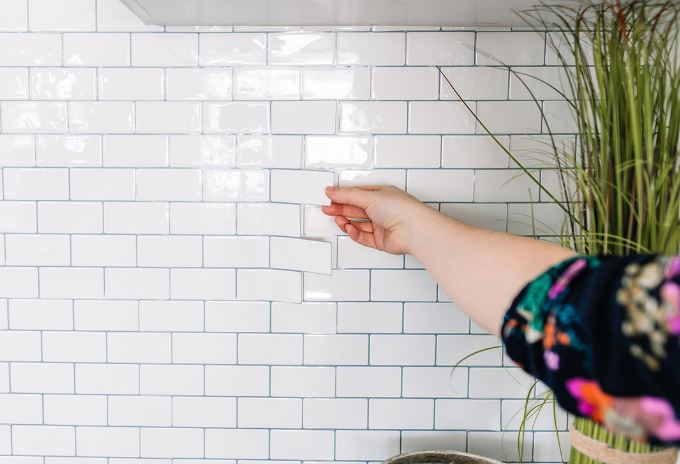First you must start with a clean, flat and dry surface. You can lay the new tile over the old tile or linoleum but the old surface needs to be secure to the floor and it needs to be thoroughly cleaned and dry and free from any irregularities.
If you are laying the tile down on a plywood or luan surface that has been nailed down it is imperative that you secure the nails from working themselves back up and through the tile.
This can be accomplished with using a fast drying substance such as Bondo that is used on cars to repair cracks and dents.
It dries very fast and hard and will secure the nails down permanently from popping back up.
This is a very time consuming process but must be done if nails have been used. Remove the molding that is running along the walls so that you can install the tile directly up to the wall.
Your second step is to find the center point of the room. You can accomplish this by using a tape measure and a chalk line.
Measure the width of the room at each end and make a mark exactly half way across the room splitting that end of the room in half. Go to the other end of the room and do exactly the same.
Secure the end of the chalk line to the first mark with a small nail or if you have a friend working with you have them hold the end of the chalk line very securely to the first mark.
Stretch the chalk line across the room to the other mark and pull the line as tight as you can and then hold it securely on the second mark you made which is dividing the width of the room in half opposite the first mark.
Lift up on the chalk line and let it snap back to the floor leaving a nice straight line of chalk which divides the width of the room exactly in half.
Go through the exact same process dividing the length of the room in half and snap a chalk line which will divide the length of the room exactly in half.
It does not matter the size of the room, this chalk line process must be used as you need to start your first tile exactly in the center of the room and work out from there.
This process should have left you with a clean, dry and flat surface with 2 chalk lines that are 90 degrees apart from each other or a simpler way of saying would be that they fit exactly on corner of the first piece of tile.
The third step is to start installing the tile onto the floor. Take your first piece of tile and turn it over to the thin paper side.
You will notice that there are arrows on the paper all pointing in the same direction. The reason for this is so you get all the tiles pointing in the same direction during installation.
Keep this in mind as you install each square that before you peal the paper off the back that you check the direction of the arrows first and rotate the tile accordingly.
The first tile that you will put down will go exactly where the chalk lines cross in the middle of the room.
Put the corner of the tile exactly on the crossing point while lining up each edge with the chalk line and press the tile down.
The positioning of the first tile is very important and at this point can be shifted slightly to make it exactly line up with the chalk lines.
Take a bakers wooden rolling pin and roll and press down on the tile as you roll over it to secure it to the floor.
Be careful not to shift the tile while you are doing this. Now take each new tile keeping in mind the direction of the arrows and put it tightly up against the first tile on the floor and carefully set it down.
Roll over each tile with the roller securing it to the floor keeping all edges tight and lined up. Do not rush this process as the tighter the fit the better the finished job will look.
The fourth and final step will be cutting the edges to fit up tightly against the walls. For this you will want to have a large thin board to use as a cutting board, a sharp construction knife, a metal straight edge and a measuring tape for all the odd corners you might run into around cabinetry and doors.
Use each tile as a template sliding it up to the wall with the paper still on it keeping in mind the direction of the arrows.
At this point the arrows need to be pointing in the opposite direction of what they normally go.
The reason for that is when you measure and cut the piece off the finished piece you will be rotating it back so that the cut edge goes up against the wall and will be covered up by molding.
At this point all the arrows will be going in the same direction. Work your way around the room taking your time with each piece keeping it tight and rolling them out and securing them tightly to the floor.
While you are doing this process you will find areas where the adhesive is on the surface of the tile and this can easily be removed with a cotton swab and some finger nail polish remover. Replace the molding around the room and you have a new floor.

